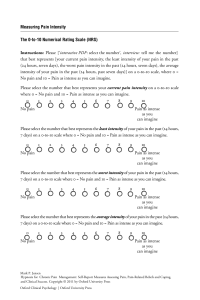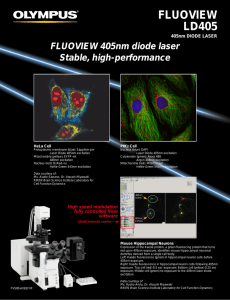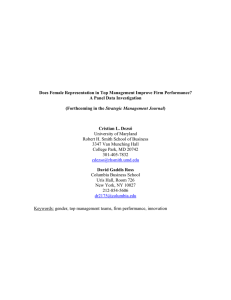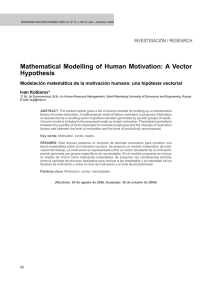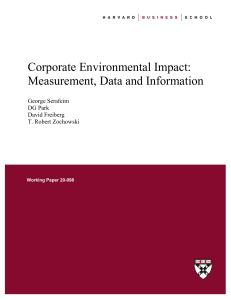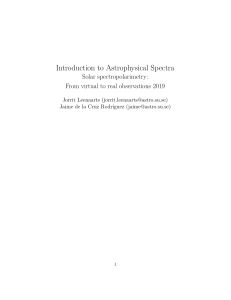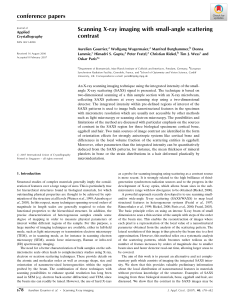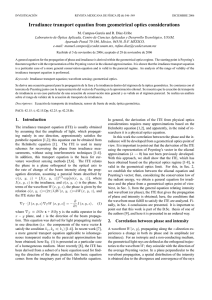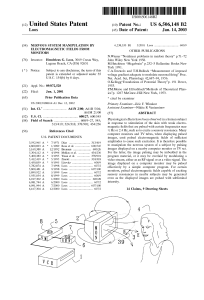New archaeointensity data from Western Europe: an
Anuncio
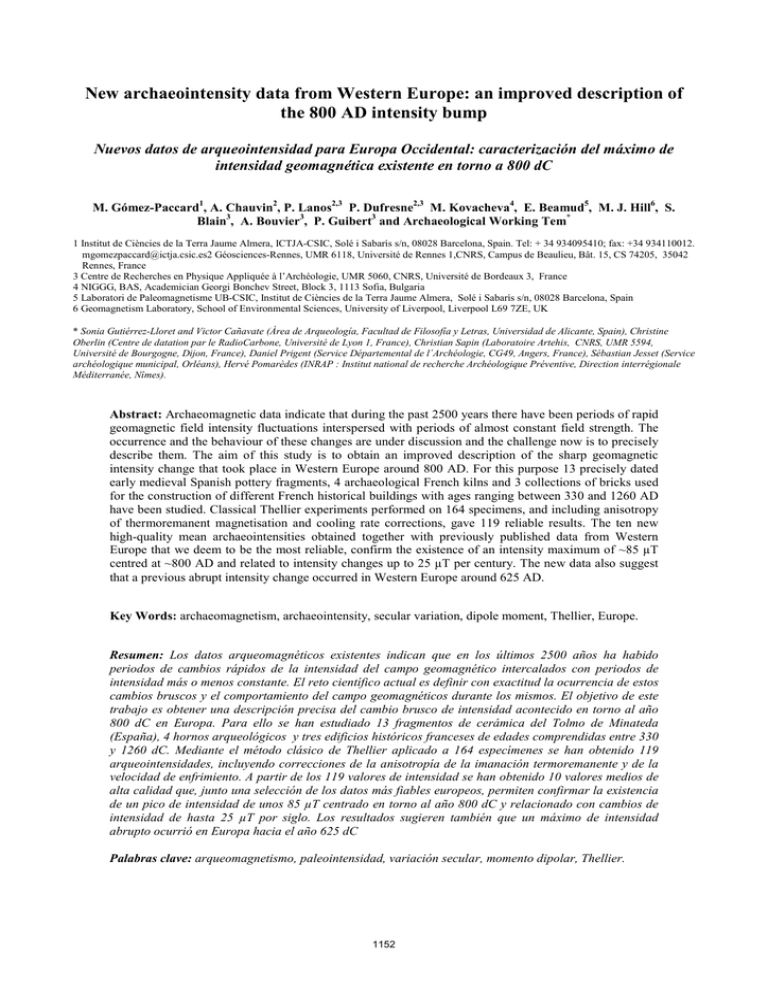
New archaeointensity data from Western Europe: an improved description of the 800 AD intensity bump Nuevos datos de arqueointensidad para Europa Occidental: caracterización del máximo de intensidad geomagnética existente en torno a 800 dC M. Gómez-Paccard1, A. Chauvin2, P. Lanos2,3 P. Dufresne2,3 M. Kovacheva4, E. Beamud5, M. J. Hill6, S. Blain3, A. Bouvier3, P. Guibert3 and Archaeological Working Tem* 1 Institut de Ciències de la Terra Jaume Almera, ICTJA-CSIC, Solé i Sabarís s/n, 08028 Barcelona, Spain. Tel: + 34 934095410; fax: +34 934110012. [email protected] Géosciences-Rennes, UMR 6118, Université de Rennes 1,CNRS, Campus de Beaulieu, Bât. 15, CS 74205, 35042 Rennes, France 3 Centre de Recherches en Physique Appliquée à l’Archéologie, UMR 5060, CNRS, Université de Bordeaux 3, France 4 NIGGG, BAS, Academician Georgi Bonchev Street, Block 3, 1113 Sofia, Bulgaria 5 Laboratori de Paleomagnetisme UB-CSIC, Institut de Ciències de la Terra Jaume Almera, Solé i Sabarís s/n, 08028 Barcelona, Spain 6 Geomagnetism Laboratory, School of Environmental Sciences, University of Liverpool, Liverpool L69 7ZE, UK * Sonia Gutiérrez-Lloret and Victor Cañavate (Área de Arqueología, Facultad de Filosofía y Letras, Universidad de Alicante, Spain), Christine Oberlin (Centre de datation par le RadioCarbone, Université de Lyon 1, France), Christian Sapin (Laboratoire Artehis, CNRS, UMR 5594, Université de Bourgogne, Dijon, France), Daniel Prigent (Service Départemental de l´Archéologie, CG49, Angers, France), Sébastian Jesset (Service archéologique municipal, Orléans), Hervé Pomarèdes (INRAP : Institut national de recherche Archéologique Préventive, Direction interrégionale Méditerranée, Nîmes). Abstract: Archaeomagnetic data indicate that during the past 2500 years there have been periods of rapid geomagnetic field intensity fluctuations interspersed with periods of almost constant field strength. The occurrence and the behaviour of these changes are under discussion and the challenge now is to precisely describe them. The aim of this study is to obtain an improved description of the sharp geomagnetic intensity change that took place in Western Europe around 800 AD. For this purpose 13 precisely dated early medieval Spanish pottery fragments, 4 archaeological French kilns and 3 collections of bricks used for the construction of different French historical buildings with ages ranging between 330 and 1260 AD have been studied. Classical Thellier experiments performed on 164 specimens, and including anisotropy of thermoremanent magnetisation and cooling rate corrections, gave 119 reliable results. The ten new high-quality mean archaeointensities obtained together with previously published data from Western Europe that we deem to be the most reliable, confirm the existence of an intensity maximum of ~85 µT centred at ~800 AD and related to intensity changes up to 25 µT per century. The new data also suggest that a previous abrupt intensity change occurred in Western Europe around 625 AD. Key Words: archaeomagnetism, archaeointensity, secular variation, dipole moment, Thellier, Europe. Resumen: Los datos arqueomagnéticos existentes indican que en los últimos 2500 años ha habido periodos de cambios rápidos de la intensidad del campo geomagnético intercalados con periodos de intensidad más o menos constante. El reto científico actual es definir con exactitud la ocurrencia de estos cambios bruscos y el comportamiento del campo geomagnéticos durante los mismos. El objetivo de este trabajo es obtener una descripción precisa del cambio brusco de intensidad acontecido en torno al año 800 dC en Europa. Para ello se han estudiado 13 fragmentos de cerámica del Tolmo de Minateda (España), 4 hornos arqueológicos y tres edificios históricos franceses de edades comprendidas entre 330 y 1260 dC. Mediante el método clásico de Thellier aplicado a 164 especímenes se han obtenido 119 arqueointensidades, incluyendo correcciones de la anisotropía de la imanación termoremanente y de la velocidad de enfrimiento. A partir de los 119 valores de intensidad se han obtenido 10 valores medios de alta calidad que, junto una selección de los datos más fiables europeos, permiten confirmar la existencia de un pico de intensidad de unos 85 µT centrado en torno al año 800 dC y relacionado con cambios de intensidad de hasta 25 µT por siglo. Los resultados sugieren también que un máximo de intensidad abrupto ocurrió en Europa hacia el año 625 dC Palabras clave: arqueomagnetismo, paleointensidad, variación secular, momento dipolar, Thellier. 1152 archeointensity data were corrected for TRM anisotropy and cooling rate effects upon TRM intensity. The TRM anisotropy effect for the ceramic fragments is generally higher than for the kilns or brick samples. In general the cooling rate correction factors applied are not very high with a maximum value of ~25%. INTRODUCTION Unravelling past changes in geomagnetic field intensity is crucial to understand the dynamics of the geodynamo and to investigate the link between solar activity, 14C, the Earth´s magnetic field and climate. Available European data indicate that during the past 2500 years there were periods of rapid intensity fluctuations, such as the one observed around 800 AD, interspersed with periods of little change, as seen during Roman times. The challenge now is to precisely describe these rapid changes and to understand how such behaviour can arise. This study provides new paleointensity data from the study of 13 precisely dated early medieval Spanish pottery fragments from el Tolmo de Minateda (TM) with ages ranging from 750 to 900 AD. In addition, four French kilns and three collections of bricks used in the construction of historical French buildings with ages ranging between 330 and 1290 AD have been studied (Fig. 1). FIGURE 2. Thellier archaeointensity results. The unblocking temperatures observed range between 410ºC and 620ºC. Together with rockmagnetic experiments (hysteresis experiments, IRM acquisition curves and thermomagnetic curves) they indicate that the main magnetic carriers in the studied samples are magnetite and Ti-poor titanomagnetites. DISCUSSION AND CONCLUSION From the 119 reliable archaeointensity estimations at specimen level, ten new high-quality archaeointensities were obtained for Western Europe. They were derived from the analysis of at least two specimens per fragment and between two and four fragments per age interval or between 4 and 37 independent samples per structure/building. Consistent values were obtained from the different material studied (Fig.3). FIGURE 1.Location of the archaeological/historical sites. RESULTS Four specimens of about 1 cm x 1 cm per pottery fragment were prepared and packed into salt pellets. Standard cores were drilled from the three collections of bricks. Large oriented blocks were taken from the mediaeval kilns. Samples were dated by thermoluminescence and/or archaeological context. Thellier experiments were attempted on 164 specimens (52 salt pellets and 112 standard cores). 119 specimens of them yield reliable absolute intensity determinations. All accepted results correspond to well-defined single component of magnetization going toward the origin and high quality NRM-TRM results (Fig. 2). The A compilation of high-quality archeointensities available for Western Europe between 200 and 1400 AD was performed (Fig. 3). Only data obtained from Thellier or Thellier-derived experiments including pTRM checks were considered (Donadini et al., 2009). Our new results are in very good agreement with previous archeointensity values (Fig. 3). 1153 FIGURE 3. Geomagnetic field intensity changes in Europe. (a) New archaeointensity data obtained in this study and selected previous results for western Europe and northern Morocco (Genevey et al., 2008); (b) selected archaeointensity data available from Bulgaria, Greece and Italy (Genevey et al., 2008). In (c) and (d) the mean Bayesian curved derived from the selected data is shown in black together with the 95% error envelope (grey area). In (e) and (f) the rates of change derived from the Bayesian curve. 1154 improved description of the geomagnetic intensity changes that took place in this region between the 4th and the 13th centuries AD. The results confirm that an intensity maximum of about 85 µT occurred in Europe at around 800-900 AD and indicate that this sharp intensity change is related to very rapid intensity changes as fast as 25 µT per century. The results also suggest that a previous abrupt intensity change took place in Europe around 650 AD. The Bayesian approach (Lanos, 2004) was used in order to obtain the geomagnetic field intensity variation described by the dataset compiled (Fig. 3). The results indicate approximately constant values between 300 and 500 AD (around 65 µT) followed by an increase of the archaeointensity up to ~85 µT around 650 AD followed by an important decrease between 650 AD and 750 AD. However, this period of high intensities is poorly defined and the results are only based on one intensity value. High intensities (of about 85 µT) are reached again very quickly around 800 AD. Rapid intensity changes as fast as 25 µT per century are observed for this period. Finally, an intensity decrease is observed between 800 AD up to 1400 AD. AGRADECIMIENTOS Financial support was given by a CSIC JAE-Doc postdoctoral research contract (MGP), by the CGL2008-02203/BTE, CGL2011-24790, and CGL2010-15767/BTE research projects from the Spanish ministry of Science and Innovation High-quality data from Bulgaria, Italy and Greece for the same period have been also compiled and treated by Bayesian modeling (Figs 3b, d). The results indicate very similar intensity changes to those observed in western Europe, with the occurrence of two intensity bumps (up to ~75 µT) at ages around 650 and 950 AD. The results also suggest that the duration of these periods of high intensities may be of less than two centuries and that extreme intensity variation as fast as 20 µT per century occurred in Eastern Europe during historical times. REFERENCIAS Donadini, F., Korte, M. and Constable, C.G.. (2009): Geomagnetic field for 0-3 ka: 1. New data sets for global modeling. Geochemistry Geophysics Geosystems, 10, Q06007, doi:10.1029/2008GC002295. Genevey, A., Gallet, Y., Constable, C.G., Korte, M., and Hulot, G., 2008. ArcheoInt: An upgraded compilation of geomagnetic field intensity data for the past ten millennia and its application to the recovery of the past dipole moment. Geochem. Geophys. Geosyst, 9, Q04038, doi:10.1029/2007GC001881. Lanos, P. (2004): Bayesian inference of calibration curves: Application to archeoamgetnism. En: Tools for Constructing Chronologies, Crossing Disciplinary Boundaries (C: E: Buck and A. R. Millard, eds.). Springer, London, 43-82. CONCLUSION New archaeointensities from the study of 13 precisely dated early medieval Spanish pottery fragments, four French kilns and three collections of bricks used for the construction of three French historical buildings with ages ranging between 330 and 1290 AD have been obtained. The new intensities -corrected for TRM anisotropy and cooling rate effects- can be considered as reliable markers of past geomagnetic field intensity. Together with a selection of the previous data that we deem to be the most reliable for Europe, they enable an 1155

